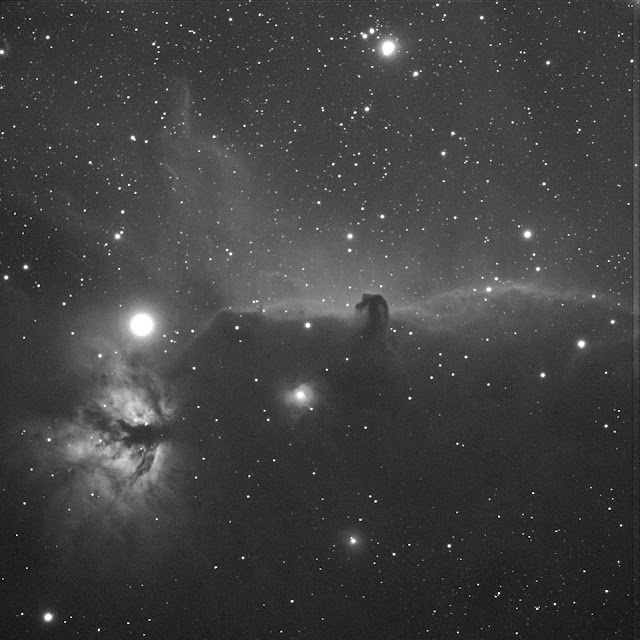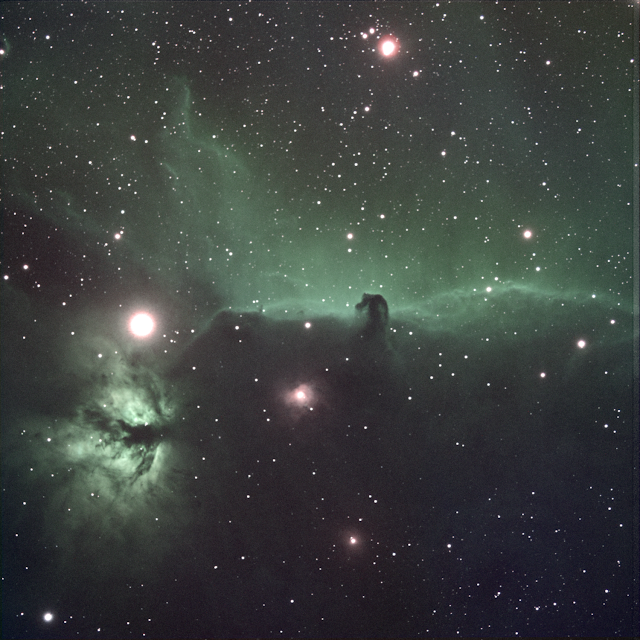Tri-colour false-colour images of the Horsehead and Flame nebulae
Note that FWHM is Full Width Half Maximum as defined below.
The Horsehead and Flame nebulae were imaged with AstroDMx Capture version 2, a William Optics Super Zenithstar 81mm ED Doublet APO refractor at f/5.5 with x 0.8 reducer/flattener, (F=445.5mm) and an SVBONY SV605MC monochrome, 14 bit, cooled CMOS camera fitted with a 7nm FWHM H-alpha, or a 6.5nm FWHM OIII filter or a 6.5nm FWHM SII filter or an Altair Quadband filter whose transmission curve covers all relevant wavelengths with two, wide, 35nm FWHM bandpasses.
The Altair Quadband OSC narrowband filter transmits two spectral bands:
FWHM spans 477.5nm - 512.5nm at the blue-green end of the visible spectrum and FWHM spans 642.5nm - 677.5nm at the red end of the spectrum.
The first band contains the emission lines of H-beta at 486.1nm and OIII at 495.9nm and 500.7nm and is centred on 495nm.
The second band contains the emission lines of H-alpha at 656.3nm and SII at 672.4nm and is centred on 660nm.
The Filter is called ‘quadband’ because it contains the emission lines of the elements H-beta, OIII, H-alphaa and SII.
Each of the two transmission bands has a FWHM of 35nm and the rest of the visible spectrum is essentially blocked.
Imaging procedures
As usual, the mount was placed on marks on the concrete base which give a fairly good polar alignment. AstroDMx Capture passed the time, altitude and location coordinates to the hand controller via the INDI server. The hand controller which now contained all of the correct information was set to its previous alignment and was unparked by AstroDMx Capture.
AstroDMx Capture was used to send the scope/mount to a bright star (Sirius) to check focus with a Bahtinov mask.
Then AstroDMx Capture sent the scope/mount to the mag 7.5 star HD37805, which lies roughly central within the Horsehead-Flame nebulosity. This is a preferred way to compose the image, than sending the scope/mount to the published coordinates of the Horsehead or the Flame nebula.
AstroDMx Capture plate-solved the field of view and centred the selected HD37805 star
6 x 5min exposures were captured with each of the OIII and H-alpha filters, 8 x 5min with the SII filter, plus 15 x 2min exposures through the Quadband filter (for luminance data) giving a total of 2 hours 10 minutes exposure time.
AstroDMx Capture v2 capturing data through an SII filter
The images were stacked and partly processed in Siril and post processed in the Gimp 2.10 and Neat Image. The colour channels were composed and luminance blended into the images in the Gimp 2,10.
Narrowband image Palettes
The Additive nature of light
From this diagram it is possible to see the colour that will be produced by combining the primary colours Red Green and Blue.
Constructing False-colour narrowband astronomical images
To construct a narrowband false colour image, the object of interest must be imaged with a monochrome camera through three narrowband filters:
H-alpha 656.3nm Red 7nm FWHM bandpass
OIII (Oxygen 3 500.7nm Blue-green 6.5nm FWHM bandpass
SII (Sulphur 2) 671.7nm & 673.0nm Deep Red 6.5nm FWHM bandpass
Transmission curve of the three filters
 The width of the transmission bandpass determines the contrast in the resulting image; the narrower the bandpass, the greater the contrast.
The width of the transmission bandpass determines the contrast in the resulting image; the narrower the bandpass, the greater the contrast.Typically, available narrowband filters have FWHM bandpasses of 3nm, 6.5-7nm or 12nm.
We shall refer to H-alpha as H, OIII as O and SII as S from now on.
It must be remembered that monochrome images are captured through the narrowband filters. Colour (in this case false colour) images can be composed by assigning an image taken through a given filter to Red, Green or Blue; R, G or B.
These are the monochrome images of the Horsehead and Flame nebulae region captured through each of the filters:
H
S
O
In addition, an image was captured through a quadband filter to provide extra luminance detail in each image at a later stage of the image processing and applied equally to each palette produced.
Quadband image for luminance
Exposure times were 30 min for H and O, 40 min for S and 30 min luminance; giving a total exposure time of 2 hours 10 minutes.
We shall now assign H, O and S each to one of the primary colour channels, R, G and B to produce a false colour image palette.
The first palette we shall construct is named for the Hubble Space telescope and has often been used in its images. In this palette, S is assigned to R, H is assigned to G and O is assigned to B.
Therefore SHO maps to RGB.
SHO Hubble palette with the luminance data blended in.
The second palette is named for the Canada, France Hawaii telescope. In this palette HOS maps to RGB.
HOS Canada, France Hawaii telescope palette with luminance data blended in.
The other palettes follow. These palettes are simply named by their RGB mappings.
HSO palette with luminance data blended in.
OHS palette with luminance data blended in.
OSH palette with luminance data blended in.
SOH palette with luminance data blended in.
It is possible to change the colour saturation of the images to enhance the information in them as can be seen in the montage below.
The SVBONY SV605MC monochrome, cooled, 14 bit CMOS camera performed flawlessly with AstroDMx Capture, and as the results show, proved to be a very capable camera.















